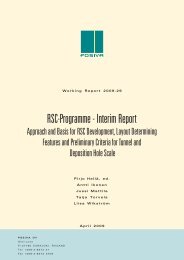Olkiluoto Biosphere Description 2006 (pdf) (4.1 MB) - Posiva
Olkiluoto Biosphere Description 2006 (pdf) (4.1 MB) - Posiva
Olkiluoto Biosphere Description 2006 (pdf) (4.1 MB) - Posiva
You also want an ePaper? Increase the reach of your titles
YUMPU automatically turns print PDFs into web optimized ePapers that Google loves.
284.2 DepositionChemical DepositionThe main chemical characteristics of precipitation (wet deposition), have beenmonitored since June 2003 with a network of rainwater collectors, replaced with snowcollectors during the winter (MRK, see Fig. A-2; Raitio et al. 2007). The interceptionfraction of annual precipitation has varied between 20% and 43% depending on thestand and the year (Table 4-3), being about 33% averaged over all monitoring plots andthe years 2004–2005.The results of deposition monitoring, presented as averages, are presented for 2004–2005 in Table 4-4, separately for open and forested terrain. The foliage of conifers isvery effective at filtering out dry deposition from the atmosphere. Dry depositioncontains varying amounts of gases (SO 2 and NO x ) forming sulphuric and nitric acids atthe surface of needles, thereby contributing to the increase in the acidity of throughfall.In the exchange reactions of base cations b (Ca 2+ , Mg 2+ , Na + , K + ), the tree foliage takesup protons and releases base cations to maintain an electrolytic equilibrium, resulting inhigher concentrations of base cations in throughfall than in open terrain. Thethroughfall also experiences a significant increase in dissolved organic carbon (DOC).This is due to the leaching of organic compounds from living and dead material in thetree crown. In addition to the exchange reactions referred to above, K is also releasedpassively from the living foliage of conifers. Potassium salts are highly soluble, and Kis therefore easily leached from dead needles in the tree crowns before they are shed. Inareas with relatively low nitrogen deposition levels, tree foliage is known to easily takeup nitrate and ammonium from the precipitation. The microflora and epiphytic lichensgrowing in the canopy also use this source of nitrogen. At <strong>Olkiluoto</strong> this is reflected inmean NO 3 -N and NH 4 -N concentrations in throughfall that are 50% and 67% lower,respectively, than in precipitation collected in open areas. The effects of the forestcanopy can therefore be clearly seen.Table 4-3. Interception of precipitation by the tree canopies in 2004 and 2005.Interception (%) was calculated as ((annual precipitation in the open – standthroughfall)/annual precipitation in the open) x 100. Plots MRK1-MRK3 are Scots pinedominated and plots MRK5-MRK8 are Norway spruce dominated.Year MRK1 MRK3 MRK4 MRK5 MRK6 MRK8 Mean2004 27% 37% 40% 40% 35% 43% 37%2005 20% 34% 38% 24% 26% 29% 28%b Base cations are defined as the most prevalent, exchangeable and weak acid cations in thesoil. Most of them are nutrients for forest ecosystems.
















